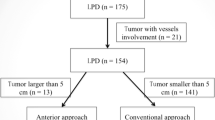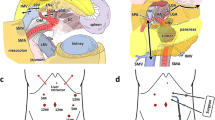Abstract
Background
The most debated aspects of laparoscopic pancreaticoduodenectomy (LPD) concern the dissection of the pancreas from the surrounding vessels and the achievement of adequate resection margins, especially in patients with pancreatic cancer.
Methods
Data of consecutive patients undergoing LPD with right artery first approach from September 2020 to September 2021 for periampullary neoplasms (pancreatic, ampullary, duodenal, distal common biliary duct) were prospectively collected and retrospectively analyzed. The overall cohort was divided into two groups: patients affected by pancreatic carcinoma (PC) and patients affected by other periampullary neoplasms (OP). Surgical and postoperative outcomes between PC and OP were compared.
Results
Thirty-one patients (15 PC and 16 OP) were selected. No difference was found between PC and OP in terms of baseline characteristics. Median resection time and overall surgical time of the entire cohort were 275 min and 530 min, respectively, without difference between the groups (p = 0.599 and 0.052, respectively). Blood loss was similar between the groups, being 350 ml in PC and 325 ml in OP (p = 0.762). One patient (3.2%) was converted to laparotomy. No difference was found between the groups in terms of pathological outcomes. Median number of retrieved lymph nodes was 17. The majority of the patients (83.9%) received an R0 resection (73.3% and 93.7% in PC and OP, respectively; p = 0.172). Postoperative surgical outcomes did not differ between the groups, excepting for overall complication rate that was higher in the OP group (26.7% vs 68.7% in PC and OP, respectively; p = 0.032).
Conclusion
Standardized right artery first approach during LPD was feasible and did not show worse surgical and postoperative outcomes in patients with pancreatic cancer as compared to those affected by other periampullary neoplasms, except for a higher rate of minor complications.
Similar content being viewed by others
References
van Hilst J, de Graaf N, Abu Hilal M, Besselink MG (2021) The landmark series: minimally invasive pancreatic resection. Ann Surg Oncol 28:1447–1456
Nassour I, Wang SC, Christie A, Augustine MM, Porembka MR, Yopp AC, Choti MA, Mansour JC, Xie X-J, Polanco PM, Minter RM (2018) Minimally invasive versus open pancreaticoduodenectomy: a propensity-matched study from a national cohort of patients. Ann Surg 268:151–157
Doula C, Kostakis ID, Damaskos C, Machairas N, Vardakostas DV, Feretis T, Felekouras E (2016) Comparison between minimally invasive and open pancreaticoduodenectomy. Surg Laparosc Endosc Percutaneous Tech 26:6–16
Adam MA, Choudhury K, Dinan MA, Reed SD, Scheri RP, Blazer DG 3rd, Roman SA, Sosa JA (2015) Minimally invasive versus open pancreaticoduodenectomy for cancer: practice patterns and short-term outcomes among 7061 patients. Ann Surg 262:372–377
Sharpe SM, Talamonti MS, Wang CE, Prinz RA, Roggin KK, Bentrem DJ, Winchester DJ, Marsh RDW, Stocker SJ, Baker MS (2015) Early National experience with laparoscopic pancreaticoduodenectomy for ductal adenocarcinoma: a comparison of laparoscopic pancreaticoduodenectomy and open pancreaticoduodenectomy from the national cancer data base. J Am Coll Surg 221:175–184
Umemura A, Nitta H, Takahara T, Hasegawa Y, Sasaki A (2018) Current status of laparoscopic pancreaticoduodenectomy and pancreatectomy. Asian J Surg 41:106–114
Pędziwiatr M, Pisarska M, Małczak P, Major P, Wierdak M, Radkowiak D, Kulawik J, Dembiński M, Budzyński A (2017) Laparoscopic uncinate process first pancreatoduodenectomy—feasibility study of a modified “artery first” approach to pancreatic head cancer. Langenbeck’s Arch Surg 402:917–923
Nagakawa Y, Hosokawa Y, Sahara Y, Takishita C, Hijikata Y, Osakabe H, Nakajima T, Shirota T, Katsumata K, Nakamura M, Tsuchida A (2018) Approaching the superior mesenteric artery from the right side using the proximal-dorsal jejunal vein preisolation method during laparoscopic pancreaticoduodenectomy. Surg Endosc 32:4044–4051
Morales E, Zimmitti G, Codignola C, Manzoni A, Garatti M, Sega V, Rosso E (2019) Follow “the superior mesenteric artery”: laparoscopic approach for total mesopancreas excision during pancreaticoduodenectomy. Surg Endosc 33:4186–4191
Giani A, Mazzola M, Morini L, Zironda A, Bertoglio CL, De Martini P, Magistro C, Ferrari G (2021) Hepatic vascular anomalies during totally laparoscopic pancreaticoduodenectomy: challenging the challenge. Updates Surg. https://doi.org/10.1007/s13304-021-01152-x
Callery MP, Pratt WB, Kent TS, Chaikof EL, Vollmer CM (2013) A prospectively validated clinical risk score accurately predicts pancreatic fistula after pancreatoduodenectomy. J Am Coll Surg 216:1–14
Mazzola M, Morini L, Crippa J, Maspero M, Zironda A, Giani A, Martini PD, Ferrari G (2020) Totally laparoscopic pancreaticoduodenectomy: technical notes. Chirurgia 115:385–393
Dindo D, Demartines N, Clavien P-A (2004) Classification of surgical complications. Ann Surg 240:205–213
Bassi C, Marchegiani G, Dervenis C, Sarr M, Abu Hilal M, Adham M, Allen P, Andersson R, Asbun HJ, Besselink MG, Conlon K, Del Chiaro M, Falconi M, Fernandez-Cruz L, Fernandez-Del Castillo C, Fingerhut A, Friess H, Gouma DJ, Hackert T, Izbicki J, Lillemoe KD, Neoptolemos JP, Olah A, Schulick R, Shrikhande SV, Takada T, Takaori K, Traverso W, Vollmer CR, Wolfgang CL, Yeo CJ, Salvia R, Buchler M, International Study Group on Pancreatic Surgery (ISGPS) (2017) The 2016 update of the International Study Group (ISGPS) definition and grading of postoperative pancreatic fistula: 11 years after. Surgery 161:584–591
Wente MN, Bassi C, Dervenis C, Fingerhut A, Gouma DJ, Izbicki JR, Neoptolemos JP, Padbury RT, Sarr MG, William Traverso L, Yeo CJ, Büchler MW (2007) Delayed gastric emptying (DGE) after pancreatic surgery: a suggested definition by the International Study Group of Pancreatic Surgery (ISGPS). Surgery 142:761–768
Wente MN, Veit JA, Bassi C, Dervenis C, Fingerhut A, Gouma DJ, Izbicki JR, Neoptolemos JP, Padbury RT, Sarr MG, Yeo CJ, Büchler MW (2007) Postpancreatectomy hemorrhage (PPH): an International Study Group of Pancreatic Surgery (ISGPS) definition. Surgery 142:20–25
Mazzola M, Giani A, Crippa J, Morini L, Zironda A, Bertoglio CL, De Martini P, Magistro C, Ferrari G (2021) Totally laparoscopic versus open pancreaticoduodenectomy: a propensity score matching analysis of short-term outcomes. Eur J Surg Oncol 47:674–680
de Fernandes E, SM, Strobel O, Girão C, Moraes-Junior JMA, Torres OJM (2021) What do surgeons need to know about the mesopancreas. Langenbecks Arch Surg. https://doi.org/10.1007/s00423-021-02211-y
Butler JR, Ahmad SA, Katz MH, Cioffi JL, Zyromski NJ (2016) A systematic review of the role of periadventitial dissection of the superior mesenteric artery in affecting margin status after pancreatoduodenectomy for pancreatic adenocarcinoma. HPB 18:305–311
Boggi U, Signori S, De Lio N, Perrone VG, Vistoli F, Belluomini M, Cappelli C, Amorese G, Mosca F (2013) Feasibility of robotic pancreaticoduodenectomy. Br J Surg 100:917–925
Palanivelu C, Rajan PS, Rangarajan M, Vaithiswaran V, Senthilnathan P, Parthasarathi R, Praveen Raj P (2009) Evolution in techniques of laparoscopic pancreaticoduodenectomy: a decade long experience from a tertiary center. J Hepatobiliary Pancreat Surg 16:731–740
Liu R, Zhang T, Zhao Z-M, Tan X-L, Zhao G-D, Zhang X, Xu Y (2017) The surgical outcomes of robot-assisted laparoscopic pancreaticoduodenectomy versus laparoscopic pancreaticoduodenectomy for periampullary neoplasms: a comparative study of a single center. Surg Endosc 31:2380–2386
Lai ECH, Yang GPC, Tang CN (2012) Robot-assisted laparoscopic pancreaticoduodenectomy versus open pancreaticoduodenectomy–a comparative study. Int J Surg 10:475–479
Nagakawa Y, Watanabe Y, Kozono S, Boggi U, Palanivelu C, Liu R, Wang S, He J, Nishino H, Ohtsuka T, Ban D, Nakata K, Endo I, Tsuchida A, Nakamura M, Hilal MA, Asbun HJ, Boggi U, Goh BKP, He J, Honda G, Jang J, Kang CM, Kooby DA, Nakamura Y, Shrikhande SV, Tang C, Wolfgang CL, Yiengpruksawan A, Yoon Y, Berardi G, Higuchi R, Takaori K, Ikenaga N, Garbarino GM, Ishikawa Y, Maekawa A, Murase Y, Zimmitti G, Sakuma L, Study group of Precision Anatomy for Minimally Invasive Hepato‐Biliary‐Pancreatic surgery (PAM‐HBP surgery) (2021) Surgical approaches to the superior mesenteric artery during minimally invasive pancreaticoduodenectomy: a systematic review. J Hepatobiliary Pancreat Sci
Pittau G, Sànchez-Cabùs S, Laurenzi A, Gelli M, Cunha AS (2015) Laparoscopic pancreaticoduodenectomy: right posterior superior mesenteric artery “first” approach. Ann Surg Oncol 22(Suppl 3):S345–S348
Boggi U, Amorese G, Vistoli F, Caniglia F, De Lio N, Perrone V, Barbarello L, Belluomini M, Signori S, Mosca F (2015) Laparoscopic pancreaticoduodenectomy: a systematic literature review. Surg Endosc 29:9–2
Mazzola M, Giani A, Crippa J, Morini L, Zironda A, Bertoglio CL, De Martini P, Magistro C, Ferrari G (2021) Totally laparoscopic pancreaticoduodenectomy: comparison between early and late phase of an initial single-center learning curve. Indian J Surg Oncol
Jiang X, Yu Z, Ma Z, Deng H, Ren W, Shi W, Jiao Z (2020) Superior mesenteric artery first approach can improve the clinical outcomes of pancreaticoduodenectomy: a meta-analysis. Int J Surg 73:14–24
Varty PP, Yamamoto H, Farges O, Belghiti J, Sauvanet A (2005) Early retropancreatic dissection during pancreaticoduodenectomy. Am J Surg 189:488–491
Weitz J, Rahbari N, Koch M, Büchler MW (2010) The “artery first” approach for resection of pancreatic head cancer. J Am Coll Surg 210:e1-4
Kendrick ML, Cusati D (2010) Total laparoscopic pancreaticoduodenectomy. Arch Surg 145
Asbun HJ, Harada E, Stauffer JA (2016) Tips for laparoscopic pancreaticoduodenectomy. J Hepatobiliary Pancreat Sci 23:E5–E9
Mendoza AS, Han H-S, Yoon Y-S, Cho JY, Choi Y (2015) Laparoscopy-assisted pancreaticoduodenectomy as minimally invasive surgery for periampullary tumors: a comparison of short-term clinical outcomes of laparoscopy-assisted pancreaticoduodenectomy and open pancreaticoduodenectomy. J Hepatobiliary Pancreat Sci 22:819–824
Ohigashi H, Ishikawa O, Eguchi H, Yamada T, Sasaki Y, Noura S, Takachi K, Miyashiro I, Murata K, Doki Y, Imaoka S (2004) Early ligation of the inferior pancreaticoduodenal artery to reduce blood loss during pancreaticoduodenectomy. Hepatogastroenterology 51:4–5
Navarro JG, Kang CM (2019) Pitfalls for laparoscopic pancreaticoduodenectomy: need for a stepwise approach. Ann Gastroenterol Surg 3:254–268
Nakata K, Higuchi R, Ikenaga N, Sakuma L, Ban D, Nagakawa Y, Ohtsuka T, Asbun HJ, Boggi U, Tang C-N, Wolfgang CL, Nishino H, Endo I, Tsuchida A, Nakamura M, Study Group of Precision Anatomy for Minimally Invasive Hepato-Biliary-Pancreatic surgery (PAM-HBP Surgery) (2021) Precision anatomy for safe approach to pancreatoduodenectomy for both open and minimally invasive procedure: a systematic review. J Hepatobiliary Pancreat Sci. https://doi.org/10.1002/jhbp.901
Funding
The authors declare that they have no funding.
Author information
Authors and Affiliations
Corresponding author
Ethics declarations
Disclosures
Drs. Michele Mazzola, Alessandro Giani, Camillo Leonardo Bertoglio, Paolo De Martini, Antonio Benedetti, Irene Giusti, Carmelo Magistro, and Giovanni Ferrari declare that they have no conflict of interest.
Additional information
Publisher's Note
Springer Nature remains neutral with regard to jurisdictional claims in published maps and institutional affiliations.
Supplementary Information
Below is the link to the electronic supplementary material.
Supplementary file1 (WMV 284530 kb)
Rights and permissions
Springer Nature or its licensor holds exclusive rights to this article under a publishing agreement with the author(s) or other rightsholder(s); author self-archiving of the accepted manuscript version of this article is solely governed by the terms of such publishing agreement and applicable law.
About this article
Cite this article
Mazzola, M., Giani, A., Bertoglio, C.L. et al. Standardized right artery first approach during laparoscopic pancreaticoduodenectomy for periampullary neoplasms: technical aspects and perioperative outcomes. Surg Endosc 37, 759–765 (2023). https://doi.org/10.1007/s00464-022-09494-2
Received:
Accepted:
Published:
Issue Date:
DOI: https://doi.org/10.1007/s00464-022-09494-2




